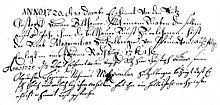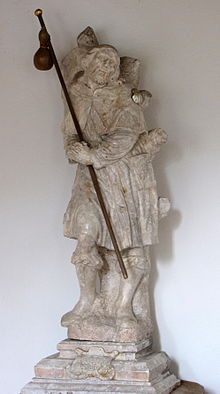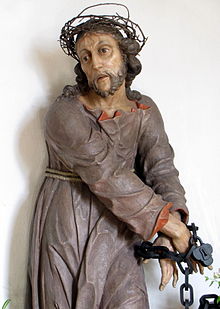Maximilian Hitzelberger
Maximilian Hitzelberger (born October 20, 1704 in Pfronten ; † August 3, 1784 in Pfronten) was a southern German Rococo sculptor. In addition, he held the office of pastor minister for decades. His son Johann Sigmund Hitzelberger (1745–1829) also exercised both professions at the same time. As a sculptor, he surpassed his father in skill, but in reputation.
Life
Maximilian Hitzelberger was the second son of the sacristan Johannes Hitzelberger and his wife Ursula Stapf. The two sons had three more daughters - a relatively small family for the time. As Michael Stapf's sister, the mother was an aunt of Mang Anton and Joseph Stapf and Maximilian was their cousin. Practically nothing is known about the private life of the Hitzelbergers. The entry in the Augsburg guild book of the sculptors (see picture!) Informs us exactly that Maximilian - like the two Stapf brothers! - completed his sculpting apprenticeship with the Augsburg master Christoph Bammer. When he started his apprenticeship in 1720, the "Maxl" was already 16 years old. However, he was waived six months from the agreed five-year apprenticeship period.
Then Hitzelberger will have gone on the usual journeyman's hike. We don't know how long he was on the road - but in a log of May 8, 1735, it can be read that Maximilian, who was no longer very young, was (still?) Away from home at this point - I don't know where . So the very late marriage of the sculptor is not surprising either. On October 21, 1743, Hitzelberger made a marriage with Maria Waibel von Pfronten. The marriage had five children. The second child - and first son - was Johann Sigmund.
Maximilian Hitzelberger reached the high age of almost 80 years at that time. After a long-lasting illness he died on August 3, 1784. The death entry reads: “ ex diuturno tandem morbo, et aetatis plenitudine potius consumptus, quam mortuus fuit honestus vir Maximilianus Hizelberger aedituus reverentiae ergo suos superiores, et fidelitatis rarum provision exemplar inumeriisuitibus etiam ipse saepius provideri et praesente D. Parocho ad superos sublevari. RP “[rather consumed by a long-lasting illness and the fullness of his age than (merely) deceased is the highly respected Mr. Maximilian Hitzelberger, guardian of deference to his superiors and rare example of reliability; He has committed himself to countless tasks and thus deserves to be provided for himself more often and to be relieved in the presence of the pastor on earth (= to be provided with the sacraments of death)].
plant
In the small community of Pfronten there was an astonishingly large number of skilled artisans around the middle of the 18th century. Peter Heel and the brothers Mang Anton and Joseph Stapf achieved national importance among the sculptors . This was not granted to the humble Maximilian Hitzelberger, who settled his figures with 1½ guilders per shoe, whereas Peter Heel z. B. demanded twice as much in Wolfegg. Nevertheless, Maximilian Hitzelberger mastered his craft with ease, both in the processing of wood and stone. An entry in the record book of the former St. Mang monastery in Füssen proves that this was also known at the time. There Hitzelberger is even referred to as a “virtuoso sculptor”. In his early days Maximilian Hitzelberger apparently also worked for a while in the Füssen workshop of the famous Anton Sturm . Even later, the skilled craftsman was apparently employed occasionally by his colleagues when there were more extensive orders to be carried out. We find figures by Hitzelberger remarkably often on Joseph Fischer's stucco marble altars. After his marriage in 1773 at the latest, Maximilian ran his workshop together with his son Johann Sigmund for several years. The circumstances mentioned make it almost impossible to reliably differentiate between all the work of the two Hitzelbergers and their Pfronten colleagues. A large number of large and also smaller crucifixes, some of which are privately owned, certainly came from Hitzelberger. They are not listed individually in the catalog raisonné. This also applies to several life-size depictions of the Savior on the scourge column that are attributed to him (e.g. in Pfronten- Berg, Bidingen , Geisenried , Pfronten-Kappel, Ketterschwang , Rückholz , Seeg and Eisenberg- Stockach).
Catalog raisonné
The directory is necessarily incomplete. Archival documented works are marked (arch.).
- around 1740: Pfronten -Röfleuten, Chapel St. Johannes Evangelist: Maria and Johannes in a group of the cross
- before 1741 (?): Vils (Tyrol), parish church of the Assumption of Mary: 2 high altar figures
- 1741: Pfronten -Oesch, St. Coloman Chapel: limestone figure of the church patron (arch.)
- around 1748: Hohenfurch , Parish Church of the Assumption of Mary : 2 high altar figures
- around 1750: Pfronten -Halden: Magnus column
- around 1750: Füssen , Franciscan monastery: crucifixion group
- around 1750: Pfronten -Heitlern, branch church St. Leonhard: 2 side altars with altar sculpture
- 1752: Füssen , St. Mang Monastery: 2 rähmlen (arch.)
- 1754: Heiterwang (Tyrol), Parish Church of the Assumption of Mary: high altar figures
- 1756: Pfronten -Ried, on the Vils: stone prayer column on a base
- 1757: Ketterschwang , parish church St. Jakobus maior: 4 high altar figures (arch.)
- 1758: Burggen , Filialkirche St. Anna: St. Paul and putti for the pulpit (arch.)
- around 1760: Vils (Tyrol), Church of St. Anna: altar figures
- 1761 (?): Sachsenried , Parish Church of St. Martin: Figure of St. Ulrich to the already existing high altar - the counterpart "St. Afra" by Joseph Stapf
- around 1762: Bernbeuren- Auerberg, St. Georg branch church: high altar sculpture
- around 1765: Füssen , St. Stephan Franciscan monastery church: high altar sculpture
- 1770: Seeg -Schwarzenbach, St. Coloman Chapel: Altar
- around 1775: Elbigenalp (Tyrol), parish church of St. Nikolaus : side altar sculpture of St. Ulrich
literature
- Anton H. Konrad, Annemarie and Adolf Schröppel: Pfronten , Schwäbische Kunstdenkmale booklet 34, Weißenhorn 1986
- Herbert Wittmann: Joseph Fischer's stucco marble work in: Yearbook of the historical association "Alt Füssen", Alt Füssen 1999, ISSN 0939-2467 , pp. 247-270.
- Klaus Wankmiller: With knife and mallet ! Works by Pfrontener Sculptors in Ausserfern - Catalog to the exhibition street (= publications of the Museum Association of the Reutte District - Volume XI, Reutte 2017). ISBN 978-3-9503706-7-6 .
Individual evidence
- ↑ Anno 1720 on December 21st, published in front of the Sütz Christopff Bammer Bilthauer, to learn the bilthauer art with a boy for the same 5 year, the boy Magximilian Hützelberger, von Pfrundten, out of Algey - Anno 1725 the 3rd of April Appears in front of the previous seat Mr. Christoph Bammer proves to his thoughtful apprentice took Magximilian Hützelberger that he behaved honestly and honestly with him, he followed up for half a year so he spoke to hirmit Loß
- ↑ State Archives Augsburg letter protocols of the Pfronten administrative office, Augsburger care offices 251, p. 83
- ↑ Annemarie Schröppel, Encounter with Pfrontner Art of the 17th and 18th Centuries , Füssen 1981, p. 10
- ^ Parish archives Ketterschwang, church accounts 1757, p. 30th
- ↑ Stadtarchiv Füssen, former St. Mang monastery archive, AR 1752-63, note : Buech , July 1752
- ↑ On sculptor work to the Maximilian Hezelberger sculptor in fronts for 4 statues Each ad 5 shoes the shoes for 1 fl 30 kr accorded to the choir altar Lauth Lit: O 30 [fl]
| personal data | |
|---|---|
| SURNAME | Hitzelberger, Maximilian |
| BRIEF DESCRIPTION | South German Rococo sculptor |
| DATE OF BIRTH | October 20, 1704 |
| PLACE OF BIRTH | Pfronten |
| DATE OF DEATH | August 3, 1784 |
| Place of death | Pfronten |





